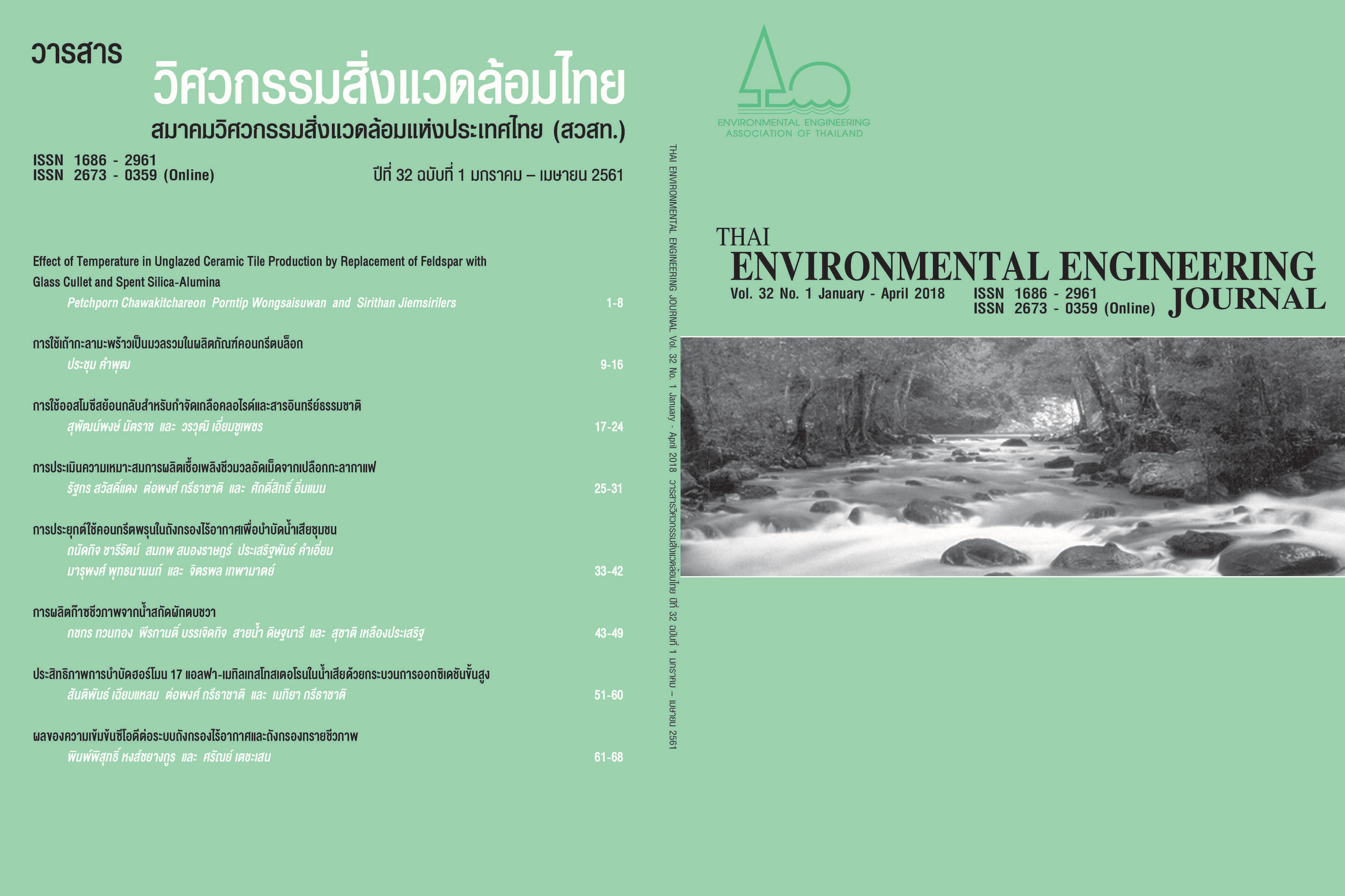Effect of Temperature in Unglazed Ceramic Tile Production by replacement of Feldspar with Glass Cullet and Spent Silica-Alumina
Main Article Content
Abstract
The objective of this research is to replace feldspar by using green glass cullet and spent silica-alumina in ceramic tile body. The ratio of ball clay with green glass cullet and spent silica-alumina used in this research was 8:5 which represented 60% of the total amount. The composite was then mixed with 40% of silica sand by using ball mill. The mixture was pressed into tiles with the size of 10 x 10 x 0.5 cm3 under the pressure of 100 bars and firing at 1150 oC and 1200oC. The physical property was analyzed according to the standard set by the Thailand Industrial Standard ref. In order to save energy during the production process, the appropriate ratio and temperature were selected. The result indicated that the mixture with the ratio between green glass cullet and spent silica-alumina of 35:65 and burned at 1150oC could pass the Thailand Industrial Standard of floor tiles (TISI 37-2529) and the Thailand Industrial Standard of wall tiles (TISI 614-2529). The mixture had the quantity of bending strength equal to 28.76 MPa, a firing shrinkage equal to 12.41% and the water absorption equal to 3.62%. The result obtained from X-ray diffraction indicated that the mullite phase which increases the strength of the ceramic tile was found.
Article Details
References
[2] Wongsaisuwan, P., Chawakitchareon, P and Jiemsirilers, S. 2011. Utilization of Green Glass Cullet and Spent Silica-Alumina for Feldspar Replacement in Unglazed Ceramic Tile Production by Ball Mill. The 20th National Grad Research and Conference, February 2-3, Mahidol University Salaya. (in Thai)
[3] Thai Industrial Standards Institute. 1986. TISI 37-2529. Ceramic tiles for floor tiles.
[4] Thai Industrial Standards Institute. 1986. TISI 614-2529. Ceramic tiles for wall tiles.
[5] Attpisarn, P. 2005. Quality Development of Ceramic Tile Produced Using Glass Waste. Master Thesis. Chulalongkorn University, Thailand. (in Thai)
[6] Rambaldi, E., Esposito, L., Tucci, A. and Timellini, G. 2007. Recycling of polishing porcelain stoneware residues in ceramic tiles. J. Eur. Ceram Soc. 27: 3509-3515.
[7] Tucci, A., Esposito, L., Rastelli, E., Palmonari, C. and Rambaldi, E. 2004. Use of soda lime scrap glass as a fluxing agent in a porcelain stoneware tile mix. J. Eur. Ceram Soc. 24: 83-92.
[8] Chawakitchareon, P., Attaphong, C. and Wichienchareon, A. 2006. Replacement of Feldspar using Glass Scrap for Ceramic Tile Production. Thai Environmental Engineering Journal, Environmental Engineering Association of Thailand. 20: 39-47. (in Thai)
[9] Chawakitchareon, P. and Tiansiri, W. 2005. Utilization of Glass Scrap as Raw Material for Ceramic Tile Production. Thai Environmental Engineering Journal, Environmental Engineering Association of Thailand. 19: 103-112. (in Thai)
[10] Wongsaisuwan, P., Pronthitipokin, C., Chawakitchareon, P. and Jiemsirilers, S. 2010. Utilization of Glass Scrap and Spent Silica-Alumina for Feldspar Replacement in Unglazed Ceramic Tile. The Proceedings of The 4th International Workshop and Conference on Earth Resource Technology, May 11-13, Phuket: Thailand. (in Thai)
[11] Pimkhaokham, P. 2004. Ceramics. Print No 5. Faculty of Science, Department of Materials Science, Chulalongkorn University. (in Thai)
[12] Chawakitchareon, P. and Tiansiri, W. 2003. Utilization of Glass Scrap as Raw Material for Ceramic Tile Production. Master Thesis. Faculty of Engineering, Chulalongkorn University, Thailand. (in Thai)
[13] Chawakitchareon, P., Pronthitipokin, C. and Jiemsirilers, S. 2012. Effects of Green Glass Scrap for Feldspar Replacement in Ceramic Tile Production. Thai Environmental Engineering Journal, Environmental Engineering Association of Thailand. 26(1): 99-106.
[14] Schneider, H., Schreuer, J. and Hildmann, B. 2008. Structure and properties of mullite. J. Eur. Ceram Soc. 28: 329-344.


